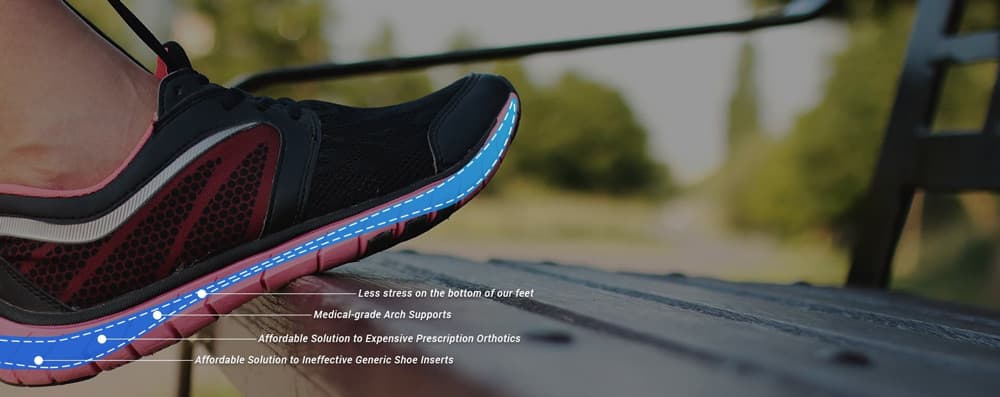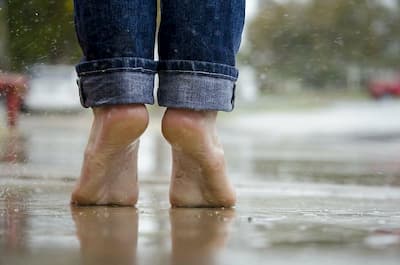
What is Plantar Fasciitis?
Plantar fasciitis is a painful condition caused by a stretching of the tendon on the bottom of the foot called the plantar fascia. Icing and stretching will only provide temporary relief to the pain while insoles provide long term pain relief. This is because the best insoles for plantar fasciitis provide very specific correction for your heel, arches and forefoot, provide cushion for your feet and reduce the pull on the plantar fascial tendon.
Treat What Causes Plantar Fasciitis
There are several causes your best insoles should address:
- Stress: standing or walking on hard surfaces can inflame the plantar fascia. Providing support to the heel, arch, and forefoot will reduce the stress on the foot.
- Sports: high impact activities that place a lot of stress on the bottom of your feet can aggravate and inflame the plantar fascia in the forefoot, arch or where it attaches into the heel bone which causes heel pain.
- Pronation: when the foot collapses inward or downward it causes a collapsing of the arch resulting in a pulling of the tendon which causes inflammation and pain. We recommend J1 Insoles as the best insole for plantar fasciitis for their medical grade support and 3-point corrective design. Depending upon the amount of pronation will determine your foot type- high/average or flat foot. Slight pronation with no excess rotation at the forefoot is a high/average foot type. Moderate to severe pronation with excess forefoot rotation is a flat foot type. J1 insoles are the best insole for plantar fasciitis whether you have high/average foot type or flat feet. J1 insoles have a patent on insoles for flat feet.
Questions to Ask Before Buying Insoles
Which Insole is Best for Flat Feet?
 Insoles for Flat Feet need to truly correct overpronation by providing support in all 3 areas of the foot to allow the foot to go into neutral. Without this 3 point correction, people with flat feet either are not going to get the support to relieve their pain or they will feel like they have a rolled up sock in their arch and that is painful. The only insole on the market to be patented to work for flat feet are J1 Insoles.
Insoles for Flat Feet need to truly correct overpronation by providing support in all 3 areas of the foot to allow the foot to go into neutral. Without this 3 point correction, people with flat feet either are not going to get the support to relieve their pain or they will feel like they have a rolled up sock in their arch and that is painful. The only insole on the market to be patented to work for flat feet are J1 Insoles.
What if I Have High Arches?
People with high or average arches also need the 3 point correction to get the foot into neutral position. Without this 3 point correction unique to J1 insoles, the foot will continue to pronate. A deep heel cup, medical grade support in the arch and an insole that goes to the ball of the foot instead of behind it is what makes J1 insoles unique design the best insole for plantar fasciitis if you have high arches. J1 insoles also contains a metatarsal pad to accommodate for the curvature at the ball of the foot thus reducing the pain associated with a neuroma and/or hammertoes.
SHOP J1 Insoles for High Arches
Do Kids Get Plantar Fasciitis?
YES!! Kids are more likely to develop plantar fasciitis between the ages of 8-15 with boys 10-15 and girls 8-13 years of age. Plantar Fasciitis in kids will more commonly develop heel pain due to the heel bone going through growth. As the heel bone grows and the arch elongates, the plantar fascia tendon needs to elongate with the foot. When there is too much pull, the tendon pulls at the attachment to the growth center of the heel bone causing Sever’s Disease.
Plantar fasciitis and Sever’s Disease are both more common in kids with flat feet. Rarely it is diagnosed in kids with high arches but is possible. J1 Juniors are the J1 insoles for kids ranging from a Toddler size 4 to a Kids 6 in both flat and high/average arch styles. We recommend J1 Juniors as the best insoles for kids who have plantar fasciitis.





